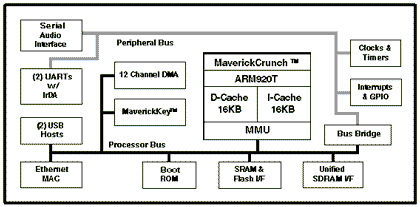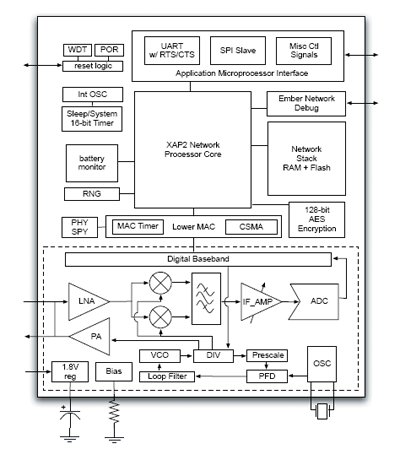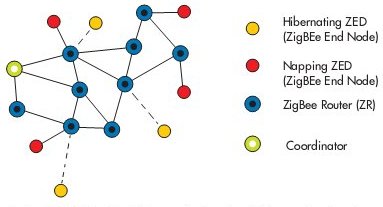Device Profile: AlertMe’s Zigbee-based home security system
Mar 19, 2008 — by Eric Brown — from the LinuxDevices Archive — 54 views AlertMe.com is shipping a ZigBee-based security system centered on a Linux-driven Hub. The AlertMe system includes a variety of sensors, fobs, and other devices that link up via wireless ZigBee connections to the Hub, which in turn reports back to AlertMe.Com's servers and the customer.
AlertMe.com is shipping a ZigBee-based security system centered on a Linux-driven Hub. The AlertMe system includes a variety of sensors, fobs, and other devices that link up via wireless ZigBee connections to the Hub, which in turn reports back to AlertMe.Com's servers and the customer.
(Click for larger view of the basic AlertMe package)
Founded in 2006 by Adrian Critchlow and Pilgrim Beart, AlertMe.com is based in Cambridge, UK. Its flagship AlertMe offering is a subscription-based security system designed to detect events such as an intruder or a fire, and alert users via SMS text messaging or email. The Linux-based Hub at the core of the system stays in constant touch with sensors and other devices scattered around the home via ZigBee. The Hub in turn communicates via a secure broadband connection to AlertMe.com's servers, which then send out alerts to the customer and authorized friends and family members.
ZigBee is a low-cost, low-bandwidth wireless technology standardized as IEEE 802.15.4. It has a fairly short range, but uses mesh networking, so signals can be relayed by intermediary devices to extend the range and avoid overloaded or disabled nodes. According to a recent ABI Research report on ZigBee and its rival Z-Wave technology, two trends are sparking renewed interest in the technology: reduced prices, and the debut of managed services via broadband. AlertMe appears to encompass both trends, costing $800 plus $23.50 a month.

Alert Me package
(Click to enlarge)
The system comprises:
- Motion sensors — detect occupancy or intruders
- Door and window sensors — detect open status
- Alarm detector — audio device that listens for any previously-installed smoke or carbon monoxide alarms
- Programmable button — currently a door alarm with custom ringtones, but in future could act as a panic button or other customizable function
- Lamp — wall-powered ZigBee router/wireless range extender and ambient-light lamp, and in the next release, a multi-colored information indicator for reporting system status, number of people in home, etc.
- Keyfob — portable device for arming and disarming the intruder alarm and alerting departing users if a door or window is unlocked
With the centralized control architecture, the AlertMe system offers some intriguing monitoring features that might seem exceedingly useful or an invasion of privacy, depending on one's point of view. For example, multiple keyfobs can be issued to different members of the family, all tracked by the central servers, so individuals can track when other individuals have left the house or have re-entered.
Beyond the SMS and email alerts, authorized users can log into AlertMe.com to gain a more complete status view, or to change settings. The entire system is remotely upgradable via software, so new features will be continually released as part of the monitoring subscription, says AlertMe.com. The company encourages customer feedback at its user forum, and responses to a survey have already indicated that customers are interested in energy monitoring features, an application that AlertMe.com is investigating.
What's under the hood
The AlertMe Hub is equipped with an ARM9-based Cirrus EP9302, which is typically clocked at 200MHz. The Hub also includes 64MB RAM and 64MB flash, plus a small boot ROM. There is no display.

Cirrus EP9302 block diagram
(Click to enlarge)
The box offers an Ethernet port, LEDs, and audio in and out, says the company. It provides both battery backup in case of power failure and a GPRS radio in case of broadband failure. It is also equipped with a ZigBee radio, using an Ember EM260 co-processor running Ember's ZigBee EmberZNet PRO stack.

Ember EM260 ZigBee processor architecture
The EM260 combines a 2.4GHz IEEE 802.15.4-compliant radio transceiver with a flash-based microprocessor running the EmberZNet ZigBee stack, says Ember. The co-processor is said to include an SPI-based interface to an application microprocessor, enabling developers to easily “ZigBee-ize” existing microcontrollers. The chipset offers immunity from WiFi interference, claims Ember.

Ember EM260 block diagram
The EmberZNet PRO embedded software provides mesh networking applications on Ember's silicon platform, supporting all major ZigBee node types (see diagram below). It is said to offer “professional grade” networking support for “challenging applications such advanced metering infrastructure (AMI), home automation, and building automation systems.”

EmberZNet PRO node support
Developing AlertMe
According to AlertMe.com Chief Architect Laura James, the Linux implementation for the AlertMe Hub is a patched version of a Cirrus distribution of the Linux mainline kernel 2.6.19. The implementation also incorporated open source ALSA and busybox components. Application software was written in Python and also used Twisted and OpenSSL.
“We started from the Linux provided with the EDB9302 development boards from Cirrus, which we used for our first prototypes before moving to a custom board,” said James in an email. “We then modded it as required ourselves.”
Linux was an easy choice, said James. “Embedded Linux is simply the right choice for a smart platform within the home,” she said. “It let us prototype quickly and move directly to volume production. It's secure, has all the features we could require in networking and support for interfaces like audio, and it's easy to work with because our engineers were already familiar with it. All our engineers have been happy with our choice, and I'm sure that would not have been the case with any alternative embedded platform.”
Looking forward, James sees a bright future for Linux-based applications in the home. “I expect to see more embedded Linux platforms in the home in the next few years, as people bring out specialist systems to address new needs in the connected home space. After that, perhaps we'll see some standardization, or single platforms hosting multiple applications. This would be more power efficient if nothing else! But I expect it'll mostly be Linux rather than other platforms, because it's easy to get working, free, secure, and reliable.”
Availability
AlertMe is available now for 400 Pounds (currently $800 US) for the introductory kit, which includes the Hub, Lamp, Button, two alarm detectors, two motion sensors, three door/window sensors, and three keyfobs. The subscription costs 11.75 Pounds ($23.50) per month.
This article was originally published on LinuxDevices.com and has been donated to the open source community by QuinStreet Inc. Please visit LinuxToday.com for up-to-date news and articles about Linux and open source.